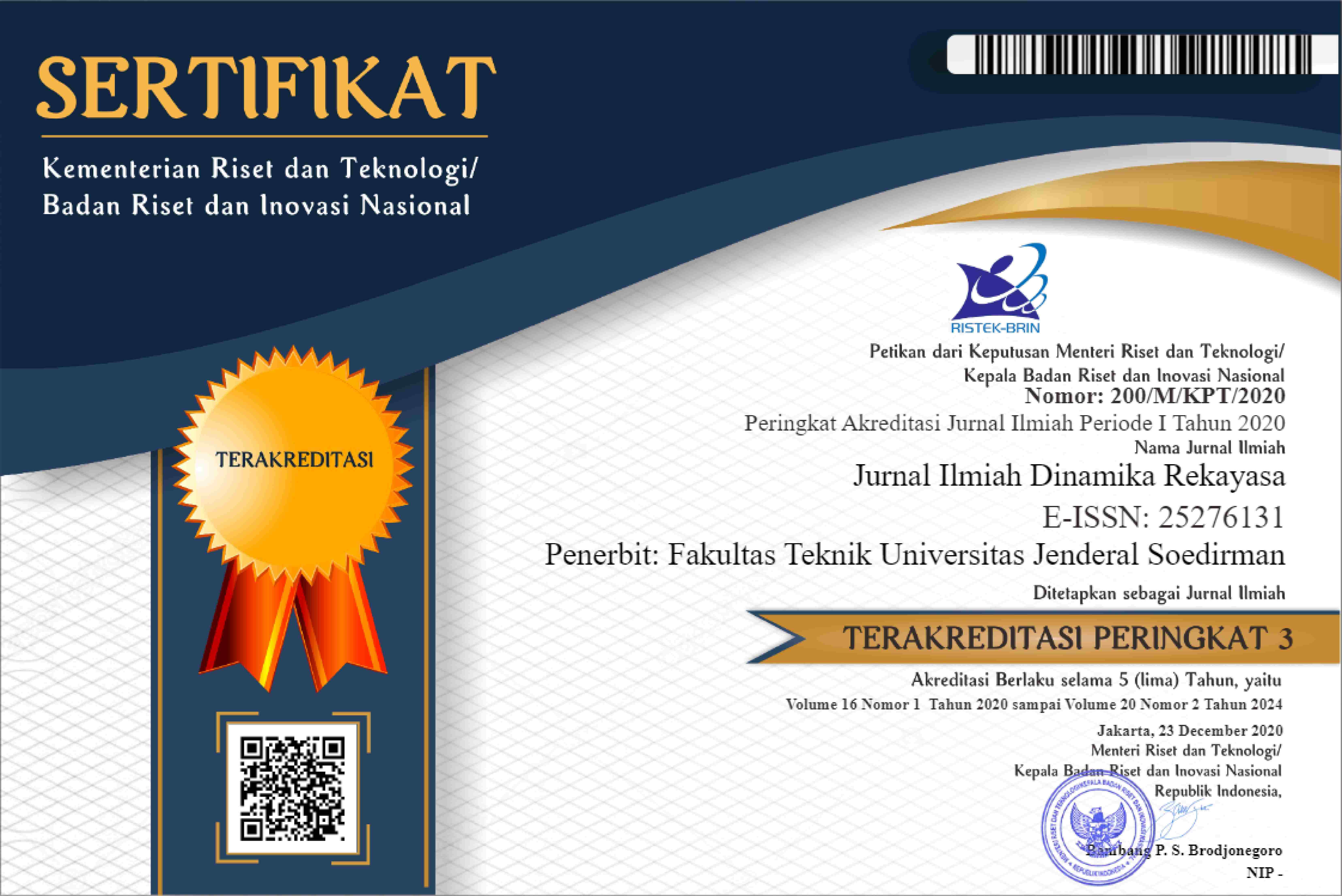Pengujian Mortar dengan Biji Plastik Polypropylene Sebagai Bahan Substitusi Pasir
Andra Yudhaswara Mulyono(1*), Relly Andayani(2)(1) Jurusan Teknik Sipil, Fakultas Teknik Sipil dan Perencanaan, Universitas Gunadarma
(2) Jurusan Teknik Sipil, Fakultas Teknik Sipil dan Perencanaan, Universitas Gunadarma
(*) Corresponding Author
Abstract
Keywords
Full Text:
PDFReferences
Warta Ekonomi, “Pemerintah Genjot Infrastruktur, Kebutuhan Pasir Melonjak,†wartaekonomi.co.id, Sep. 2018.
H. S. Mueller, M. Haist, J. S. Moffatt, and M. Vogel, “Design, Material Properties and Structural Performance of Sustainable Concrete,†Procedia Engineering, vol. 171, pp. 22–32, 2017.
J. R. Jambeck et al., “Plastic waste inputs from land into the ocean,†Science, vol. 347, no. 6223, pp. 768–771, 2015.
M. Glavind and C. Munch-Petersen, “‘Green’concrete in Denmark,†Structural concrete, vol. 1, no. 1, pp. 19–25, 2000.
Y.-W. Choi, D.-J. Moon, J.-S. Chung, and S.-K. Cho, “Effects of waste PET bottles aggregate on the properties of concrete,†Cement and Concrete Research, vol. 35, no. 4, pp. 776–781, 2005.
K. Hannawi, S. Kamali-Bernard, and W. Prince, “Physical and mechanical properties of mortars containing PET and PC waste aggregates,†Waste management, vol. 30, no. 11, pp. 2312–2320, 2010.
Z. Z. Ismail and E. A. Al-Hashmi, “Use of waste plastic in concrete mixture as aggregate replacement,†Waste management, vol. 28, no. 11, pp. 2041–2047, 2008.
B. Safi, M. Saidi, D. Aboutaleb, and M. Maallem, “The use of plastic waste as fine aggregate in the self-compacting mortars: Effect on physical and mechanical properties,†Construction and Building Materials, vol. 43, pp. 436–442, 2013.
X. Su and X. Zhang, “A detailed analysis of the embodied energy and carbon emissions of steel-construction residential buildings in China,†Energy and Buildings, vol. 119, pp. 323–330, 2016.
K. A. Aghdam, A. F. Rad, H. Shakeri, and J. M. Sardroud, “Approaching green buildings using eco-efficient construction materials : a review of the state-of-the-art,†Journal of Construction Engineering and Project Management, vol. 8, no. 3, pp. 1–23, 2018.
J. Thorneycroft, J. Orr, P. Savoikar, and R. J. Ball, “Performance of structural concrete with recycled plastic waste as a partial replacement for sand,†Construction and Building Materials, vol. 161, pp. 63–69, 2018.
L. Kaiping, C. Hewei, and Z. Jing’en, “Investigation of brucite-fiber-reinforced concrete,†Cement and Concrete Research, vol. 34, no. 11, pp. 1981–1986, 2004.
I. H. Alfahdawi, S. A. Osman, R. Hamid, and A. I. Al-Hadithi, “Utilizing waste plastic polypropylene and polyethylene terephthalate as alternative aggregates to produce lightweight concrete: A review,†Journal of Engineering Science and Technology, vol. 11, no. 8, pp. 1165–1173, 2016.
R. Siddique, J. Khatib, and I. Kaur, “Use of recycled plastic in concrete: A review,†Waste Management, vol. 28, no. 10, pp. 1835–1852, 2008.
F. Iucolano, B. Liguori, D. Caputo, F. Colangelo, and R. Cioffi, “Recycled plastic aggregate in mortars composition: Effect on physical and mechanical properties,†Materials & Design (1980-2015), vol. 52, pp. 916–922, 2013.
J. M. Irwan, R. M. Asyraf, N. Othman, K. H. Koh, M. M. K. Annas, and S. K. Faisal, “The Mechanical Properties of PET Fiber Reinforced Concrete from Recycled Bottle Wastes,†Advanced Materials Research, vol. 795, pp. 347–351, 2013.
A. I. Al-Hadithi, “Some properties of concrete using waste plastic fiber with a very small percentages,†in The First International Engineering Sciences Conference of Aleppo University (IESC" 2008), 2008, pp. 93–101.
M. J. Islam, N. Sarwar, and S. Al Shafian, “An Investigation of Concrete Properties with Polypropylene (Pp) As An Partial Replacement of Coarse Aggregate.†Islamic University of Technology, Gazipur, Bangladesh, 2015.
S. T. Wicaksono, H. Ardhyananta, and A. Rasyida, “Study on mechanical and physical properties of composite materials with recycled PET as fillers for paving block application,†AIP Conference Proceedings, vol. 1945, no. 1, pp. 1–6, Apr. 2018.
M. W. Tjaronge, M. A. Caronge, and N. Basir, “Karakteristik Mortar Berbahan Limbah Plastik Polypropylene (PP) dan Abu Sekam Padi,†Lambung Mangkurat University, pp. 1–9, 2019.
K. Hannawi, W. Prince, and S. K. Bernard, “Strain capacity and cracking resistance improvement in mortars by adding plastic particles,†Journal of materials in civil engineering, vol. 25, no. 11, pp. 1602–1610, 2013.
S. Rahimi R., I. M. Nikbin, H. Allahyari, and S. Habibi T., “Sustainable approach for recycling waste tire rubber and polyethylene terephthalate (PET) to produce green concrete with resistance against sulfuric acid attack,†Journal of Cleaner Production, vol. 126, pp. 166–177, 2016.
B. Z. Afridi, K. Shahzada, and M. T. Naqash, “Mechanical Properties of Polypropylene Fibers Mixed Cement-Sand Mortar,†Journal of Applied Engineering Science, vol. 17, no. 2, pp. 116–125, 2019.
G. Kaur and S. Pavia, “Durability of Mortars Made with Recycled Plastic Aggregates: Resistance to Frost Action, Salt Crystallization, and Cyclic Thermal–Moisture Variations,†Journal of Materials in Civil Engineering, vol. 33, no. 2, pp. 1–14, 2021.
F. Casanova-del-Angel and J. L. Vázquez-Ruiz, “Manufacturing Light Concrete with PET Aggregate,†ISRN Civil Engineering, vol. 2012, pp. 1–10, 2012.
M. Nicko, A. Setyabudi, and M. Chalid, Karateristik Material Regrind Komposit PP/Talcum Hasil Proses Hot Melt Mixing Material. Jakarta: Universitas Indonesia, 2011.
M. A. Cowd, “Kimia Polimer.†Institut Teknologi Bandung, Bandung, 1991.
M. Gachter, Plastic Additives Handbook, Third Edit. Munich: Hanser Publisher, 1990.
ASTM International, “Standard Specification for Mortar for Unit Masonry,†2001.
Badan Standardisasi Nasional, “Metode pengujian kekuatan tekan mortar semen portland untuk pekerjaan sipil,†2002.
H. M. Abdelmoti and M. A. Mustafa, “Use of Polypropylene Waste Plastic Pellets as Partial Replacement for Fine Aggregate in Concrete,†University of Khartoum Engineering Journal, vol. 9, no. 1, pp. 37–43, 2019.
D. R. Ochbelagh, S. AzimKhani, and H. Gasemzadeh Mosavinejad, “Effect of gamma and lead as an additive material on the resistance and strength of concrete,†Nuclear Engineering and Design, vol. 241, no. 6, pp. 2359–2363, 2011.
A. Usman, M. H. Sutanto, and M. Napiah, “Effect of recycled plastic in mortar and concrete and the application of gamma irradiation-a review,†in E3S Web of Conferences, 2018, vol. 65, pp. 1–12.
Refbacks
- There are currently no refbacks.





